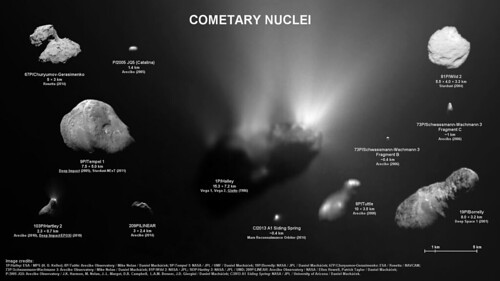Here's my list (which is currently posted
on the Society's website):
International Cometary Explorer (ICE) [Formerly Known as International Sun-Earth Explorer (ISEE-3)], Comet Giacobini-Zinner flyby and distant Halley observer (NASA)
Launch: August 12, 1978. Flyby: September 11, 1985
Vega 1 and Vega 2, Comet 1P/Halley flybys (Soviet Academy of Sciences)
Launch: December 15 and 21, 1984. Flyby: March 6 and 9, 1986
Sakigake, Comet 1P/Halley flyby (Institute of Space and Aeronautical Science (ISAS))
Launch: January 8,1985. Flyby: March 11, 1986
Suisei, Comet 1P/Halley flyby (Institute of Space and Aeronautical Science (ISAS))
Launch: March 18, 1985. Flyby: March 8, 1986
Giotto, Comets 1P/Halley and 26P/Grigg-Skjellerup flyby (ESA)
Launch: July 2, 1985. Halley flyby: March 13, 1986. Grigg-Skjellerup flyby: July 10, 1992
Galileo, Flyby of asteroids 951 Gaspra and 243 Ida; Jupiter orbiter (NASA)
Launch: October 18, 1989. Gaspra flyby: October 29, 1991. Ida/Dactyl flyby: August 28, 1993. Witnessed Shoemaker-Levy crash: July 1994
Near Earth Asteroid Rendezvous (NEAR), Asteroid 433 Eros orbiter (eventually used as a lander!) (NASA)
Launch: February 17, 1996. Eros arrival: February 14, 2000. Eros landing: February 12, 2001
Deep Space 1, Flybys of asteroid 9969 Braille and comet 19P/Borrelly (NASA)
Launch: October 24, 1998. Braille flyby: July 28, 1999. Borrelly flyby: September 22, 2001
Stardust, Flyby and coma sample return from comet P/Wild 2
Launch: February 7, 1999. Wild 2 flyby: January 2, 2004. Sample return: January 15, 2006
Comet Nucleus Tour (CONTOUR), Failed multi-comet flyby (NASA)
Launch: July 3, 2002. Lost August 15, 2002
Deep Impact, Flyby and impact into comet 9P/Tempel 1
Launch: January 12, 2005. Tempel 1 impact and flyby: July 4, 2005
Hayabusa (MUSES-C), Orbiter and sample return from asteroid Itokawa (1998 SF36) (ISAS)
Launch: May 9, 2003. Itokawa arrival: September 2005
Rosetta, Comet 67P/Churyumov-Gerasimenko orbiter and lander (ESA)
Launch: March 2, 2004. Churyumov-Gerasimenko arrival: 2014
Dawn, Planned 4 Vesta and 1 Ceres orbiter (NASA)
Launch: planned for May 27, 2006 (suspended indefinitely)
Looks like my list is missing NEAR at Mathilde and Cassini at Masursky (and I've got to update the Hayabusa info on the page). I'll wait for this thread to develop a bit and then get to work

Do you all think that the Ulysses comet tail encounters "count"?
--Emily

